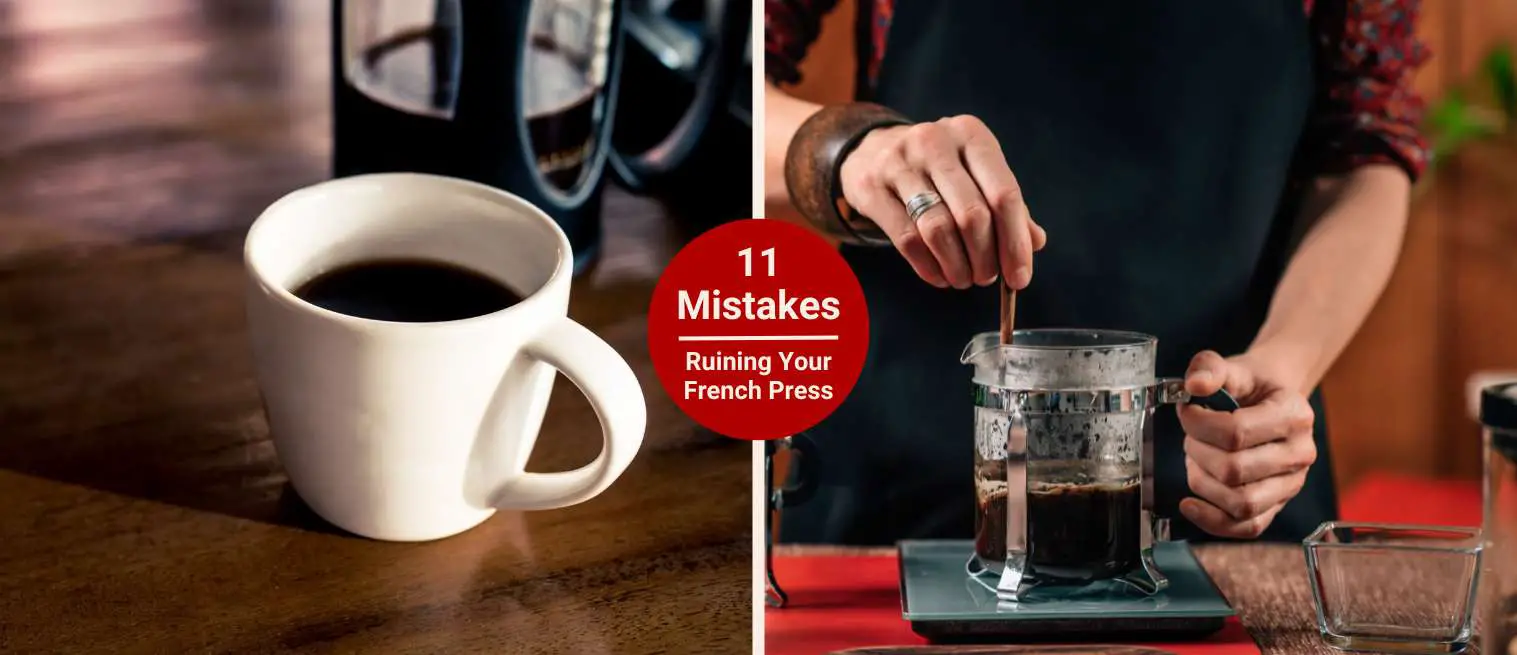11 French Press Mistakes You Must Avoid (Better Coffee Tips)
Are you sure you’re brewing your French press the right way?
Even though I love my Barista Express, I can’t deny my love for French press coffee. It’s a totally different ball game! Simple on the surface, but full of little tricks that make or break your cup.
I’ve learned the hard way that a few small slip-ups can turn bold, rich coffee into something bitter, weak, or plain gritty.
That’s why I’ve put together this guide on the most common French Press Mistakes people make.
By the end, you’ll know exactly what to avoid and the pro tips that will help you brew tasty and smooth coffee. So let’s start brewing!
11 French Press Mistakes and Fixes (Quick Cheat Sheet)
Here’s a handy cheat sheet you can save for later. Every common mistake has a simple fix, and if you’d like the full details, just keep reading.
| Mistake | Fix |
|---|---|
| 1. Using the wrong grind size | Use coarse, even grinds (like sea salt) for balanced extraction |
| 2. Not measuring coffee and water properly | Stick to ~1:15 ratio (1 g coffee : 15 g water) or 2 tbsp per 6–8 oz |
| 3. Using stale coffee | Grind fresh beans just before brewing |
| 4. Brewing with water too hot/cold | Use water at 195–205°F (just off the boil) |
| 5. Skipping the bloom | Let grounds bloom for ~30 seconds to release CO₂ |
| 6. Not stirring the grounds | Stir gently after bloom to saturate all grounds |
| 7. Brewing too long/too short | Aim for ~4 minutes steep time |
| 8. Pressing the plunger too fast | Press slowly and steadily; stop just above the bottom |
| 9. Leaving coffee in the French press | Pour all coffee out immediately after plunging |
| 10. Not cleaning the French press properly | Rinse after each use, deep clean weekly |
| 11. Expecting espresso from a French press | Enjoy it for rich, smooth coffee—not espresso |
Mistake 1) Using the Wrong Grind Size
If I had to pick the one mistake I see most often (and yep, I’ve made it myself), it’s using the wrong grind size. The first time I brewed with a French press, I grabbed a bag of pre-ground espresso coffee I normally use for my Barista Express machine. The result? A thick, sludgy cup that tasted like muddy water.
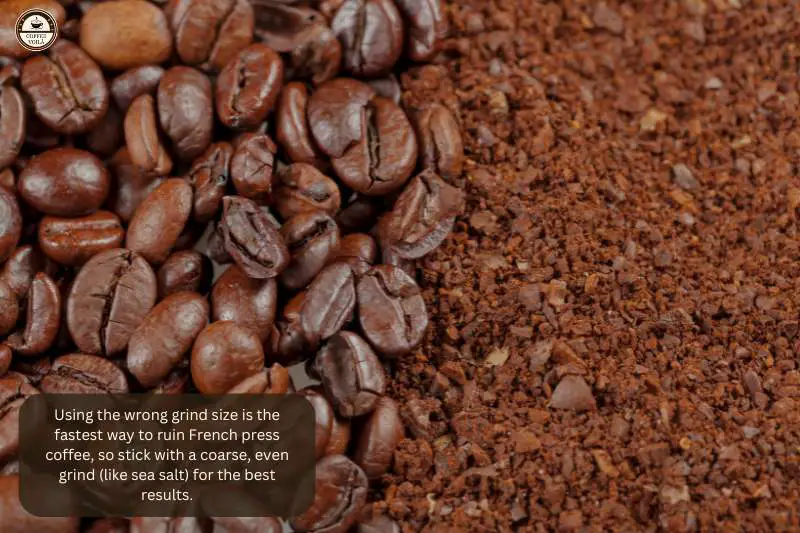
What’s the problem?
When you use fine espresso grinds, they slip right through the mesh filter and keep steeping even after you push down the plunger. That over-extraction gives you bitter coffee and a gritty mouthfeel.
Go too coarse, and you get the opposite issue. I once tried grinding beans extra chunky (think big breadcrumbs), and the result was a weak, watery cup that barely tasted like coffee.
That’s classic under-extraction. Basically, the water doesn’t spend enough time pulling out the good stuff from the beans.
So, what’s the sweet spot?
A coarse, even grind, similar to sea salt. This size keeps the grounds large enough to stay behind the filter. However, small enough to extract the bold, full-bodied flavors French press coffee is famous for.
Tip: I recommend investing in a burr grinder instead of a blade grinder. The reason is that burr grinders give you a consistent grind size.
Meanwhile blades chop unevenly (and uneven grinds = uneven flavor). A great entry-level option is the Baratza Encore (or the upgraded Baratza Encore ESP for even more precision).
Mistake 2 – Not Measuring Coffee and Water Properly
When you don’t measure your coffee and water, every brew is a gamble. Sometimes it tastes okay. But more often you’ll end up with coffee that’s either too strong and bitter or too weak and watery.
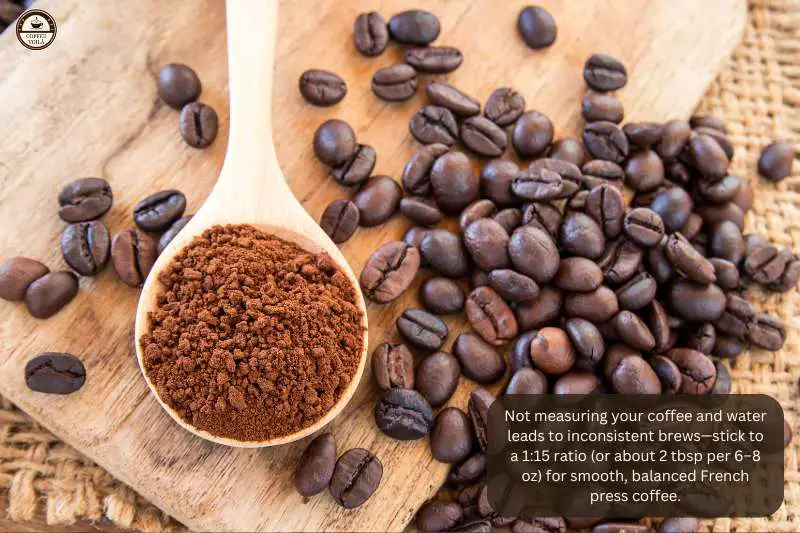
What’s the problem?
Well, guessing ratios leads to inconsistency, and that’s one of the biggest frustrations with French press brewing.
The recommended ratio is about 1:15. That’s 1 gram of coffee for every 15 grams of water. In practical terms, this works out to around 30 grams of coffee for a 450 ml (15 oz) French press, or 65–70 grams for a full liter.
For this, using a digital scale is the easiest way to stay consistent. You don’t need an expensive one (any small kitchen scale will do). Once you start measuring, you’ll notice your French press coffee comes out much more predictable and enjoyable.
Tip: If you don’t have a scale, use about 2 tablespoons of coffee per 6–8 oz of water. It’s not perfect, but it’s still way better than guessing.”
Mistake 3 – Using Stale Coffee
One of the sneakiest reasons French press coffee ends up tasting flat is stale beans. Usually, coffee is at its peak within a couple of weeks of roasting. After that, the flavors start to fade.
By the time you’re scooping from a bag that’s been sitting open for a month, you’re basically brewing with lifeless beans. And no matter how perfect your grind or water temperature is, stale coffee will ruin it all.
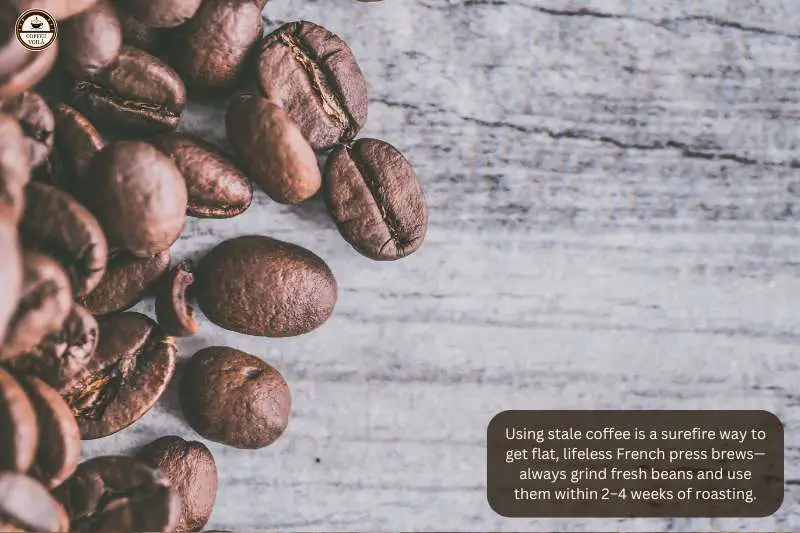
Pre-ground coffee trap…
Sure, it’s convenient, but the moment beans are ground. For this reason, they lose their freshness much faster because more surface area is exposed to oxygen.
That means the aroma and the bright notes you’d get in a fresh French press brew disappear before you even open the bag.
What’s the fix?
Grind your beans before brewing. When you grind on the spot, you keep all those natural oils and aromas locked in until the last moment. This makes a huge difference in the cup.
Tip: If you buy whole beans, look for a roast date (not just a “best by” date) on the bag. You want to use beans within 2–4 weeks of roasting.
Mistake 4 – Brewing with Water That’s Too Hot (or Too Cold)
Water temperature can make or break your French press coffee, and it’s one of those things you might overlook. You might think, “Hot water is hot water, right?” Wrong.
The fact is pouring boiling water straight over your grounds scorches them. And you get a coffee that tastes harsh, and bitter.
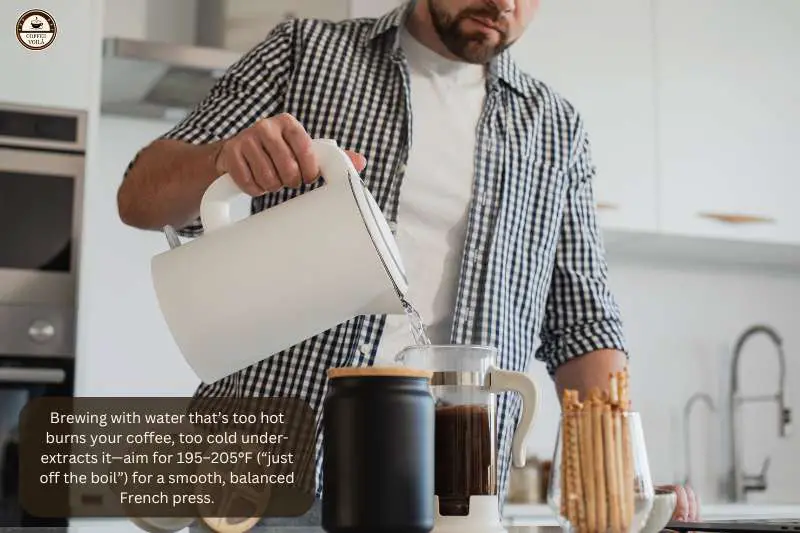
On the other hand, if your water’s too cool, you’ll encounter the opposite problem. Probably, you’ve rushed and poured before the kettle was ready.
As a result, you end up with sour and thin coffee that feels like it never really brewed. That happens because the water didn’t pull enough flavor from the grounds.
What’s the sweet spot?
You want your water between 195–205°F (90–96°C). That’s “just off the boil.” The easiest trick is to let your water sit for about 30 seconds after boiling before you pour.
Tip: Preheating your French press with hot water before brewing keeps things more stable. It’s a small step, but it goes a long way toward getting that smooth and balanced cup every time.
Mistake 5 – Skipping the Bloom
Here’s a step a lot of people don’t even know exists: blooming your coffee. Basically, it’s letting your grounds release gas before you start the full brew.
When coffee is fresh, it’s packed with CO₂. If you pour water straight in and skip the bloom, that gas fights extraction. In other words, your coffee ends up tasting flat, uneven, or slightly sour, even if everything else is right.

So how do you do it?
Super simple. You add enough hot water to cover the grounds (don’t fill the press yet). Then let it sit for about 30 seconds. You’ll see bubbles rising, sometimes a little foam forming on top. That’s the CO₂ escaping.
Once it’s gone, your water can actually interact with the coffee instead of battling trapped gas.
I used to skip this step because I thought it was overkill. But the first time I bloomed my coffee, the difference was clear. The cup was smoother, fuller-bodied, and had more of that rich aroma I wanted from my beans.
Tip: Stir gently after the bloom to make sure all the grounds are saturated.
Mistake 6 – Not Stirring the Grounds
You’d think pouring hot water over them would be enough, right? But nope. The reason is that coffee grounds love to clump together. When they do, some parts get over-extracted while others barely brew at all.
That leaves you with a cup that’s patchy. For instance, some sips are too bitter, while others are too weak.
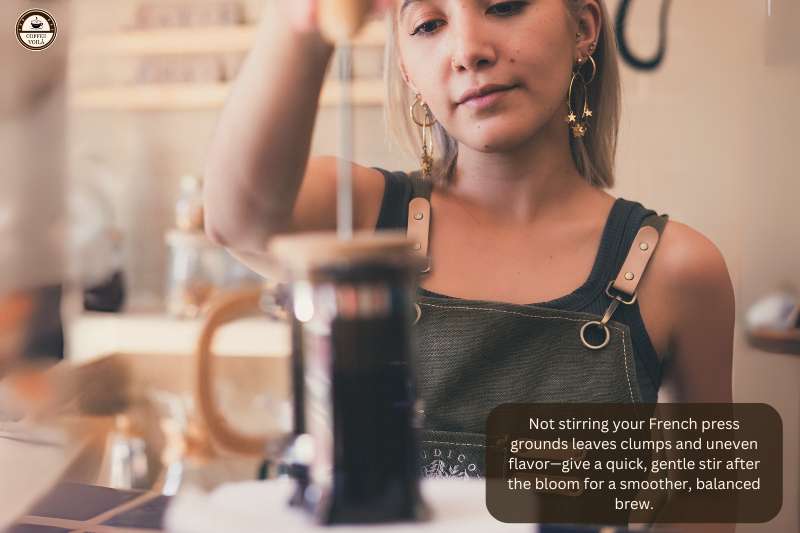
What’s the fix?
Stir it after the bloom. Use a wooden spoon or even the back of a chopstick (metal spoons can sometimes crack glass presses if you’re not careful. I’ve already broken two that way).
You want to swirl everything so all the grounds get evenly soaked gently. This takes maybe five seconds. But it can completely change the balance of your brew.
Tip: Don’t go crazy stirring, though. You’re not whisking eggs. Just a couple of gentle turns to break up the clumps is enough. You’ll notice the difference immediately in how smooth and consistent your coffee tastes.
Mistake 7 – Brewing Too Long (or Too Short)
Timing is everything with French press coffee. If you let it steep too short, you’ll end up with a sour cup that tastes thin. Otherwise, if you walk away and forget it for too long, prepare for a bitter coffee that tastes similar to chewing on burnt toast.
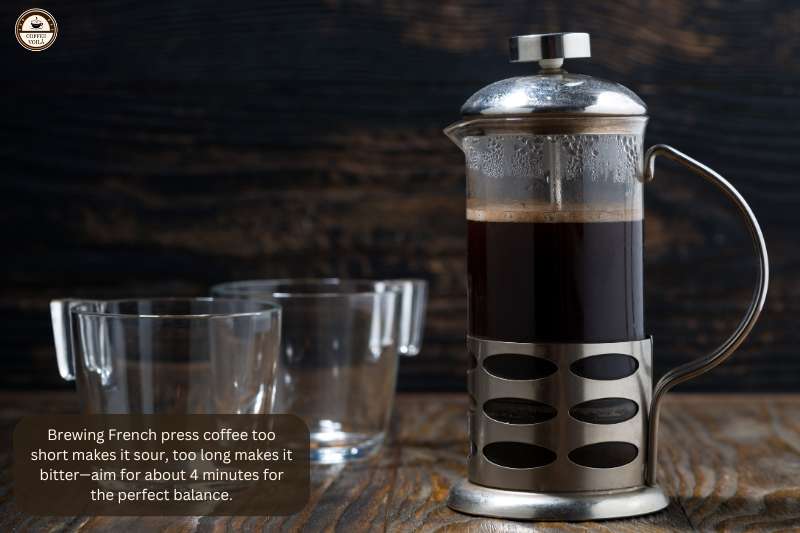
What is the perfect timing?
Around 4 minutes. That is where the coffee develops body, richness, and balance without tipping into harshness. I used to think I could “eyeball it.”
However, those extra 30–60 seconds do make a difference. You don’t need a fancy timer, though. For this, your phone’s stopwatch or even humming a favorite song works.
Just try to stay consistent. Once you lock in your personal preference (maybe you like it closer to 3:30 or 4:30), it becomes second nature.
Tip: If you’re brewing lighter roasts, they sometimes need a bit more time to open up. On the other hand, dark roasts can become bitter quickly. So stick closer to the 4-minute mark.
Mistake 8 – Pressing the Plunger Too Fast
I get it, you’re eager for that first sip. However, rushing this step can leave you with a cup full of grit or, worse, hot coffee splashing out of the top. Been there, there’s nothing fun about wiping down coffee-stained counters before you’ve even had your caffeine.
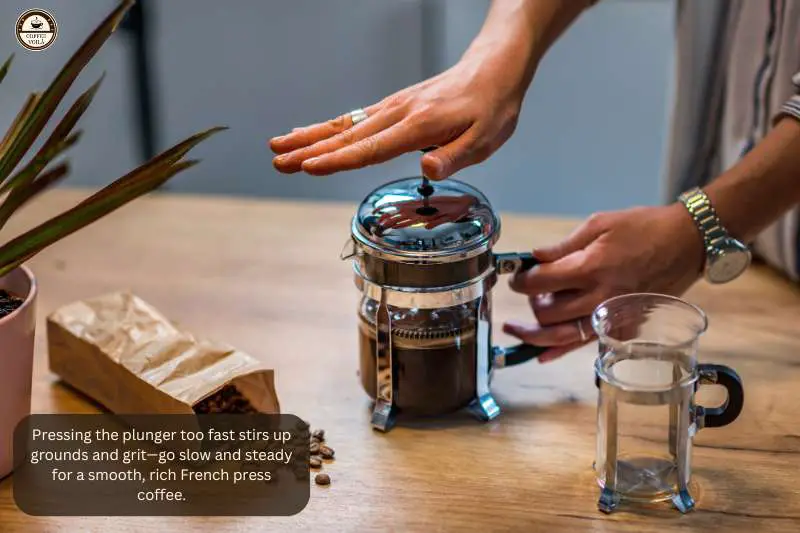
Why does this happen?
When you slam the plunger down, the mesh filter forces the grounds into motion, stirring everything back into the liquid you carefully brewed.
The result is a muddy cup. Sometimes you even feel those tiny particles between your teeth. On the flip side, if you slow things down and press gently, the filter does its job. It separates the grounds and leaves you with smooth and rich coffee.
A trick that helped me was using steady pressure, taking about 20–30 seconds to lower the plunger all the way.
Tip: Don’t push the plunger all the way to the bottom. You want to stop just shy of it. That little space keeps sediment from stirring back up.
Mistake 9 – Leaving Coffee in the French Press
You’d think that once you press down, the brewing is over, right? Not exactly. The grounds are still hanging out at the bottom, and they keep steeping in the liquid. That slow over-extraction makes your coffee go from smooth and balanced to bitter and harsh.

What’s the fix?
Simple, once you press, you want to pour it all out right away. If you don’t plan to drink it immediately, transfer it into a thermal carafe or insulated mug. This way, you keep the good flavors locked in without the bitterness creeping in.
Tip: Think of your French press as a brewer rather than a storage container. The sooner you separate the coffee from the grounds, the better your cup will taste.
Mistake 10 – Not Cleaning the French Press Properly
The first few times you skip a proper scrub, you probably won’t notice. But coffee oils are stubborn, and once they build up, they turn rancid.
Suddenly, your brew tastes off—like someone slipped a spoonful of old fryer grease into your cup.
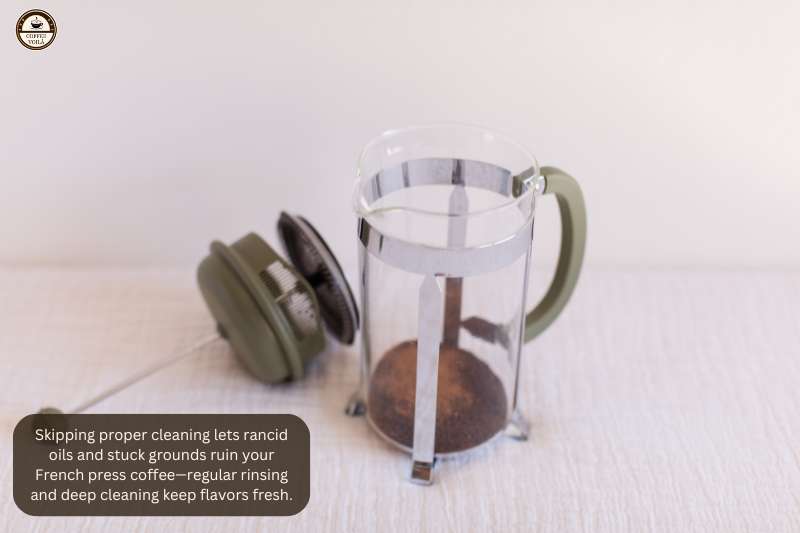
The filter is the biggest problem here. Usually, grounds get stuck in those little mesh holes, and if you don’t clean them out, it messes with the press and your flavor.
Every couple of brews, disassemble the plunger completely. It takes two minutes, but it saves your coffee.
Tip: Avoid using harsh dish soaps that leave a scent behind. You want to stick with mild soap or even baking soda. And if you’re brewing daily, do a quick rinse after each use and a deep clean at least once a week.
Mistake 11 – Expecting Espresso from a French Press
A French press is a steeping method. This means coffee grounds sit in hot water for a few minutes, which pulls out flavor and oils.
On the other hand, espresso needs high pressure (around 9 bars!) to push hot water through very fine grounds. For this reason, you get that crema layer and concentrated punch in a tiny cup.
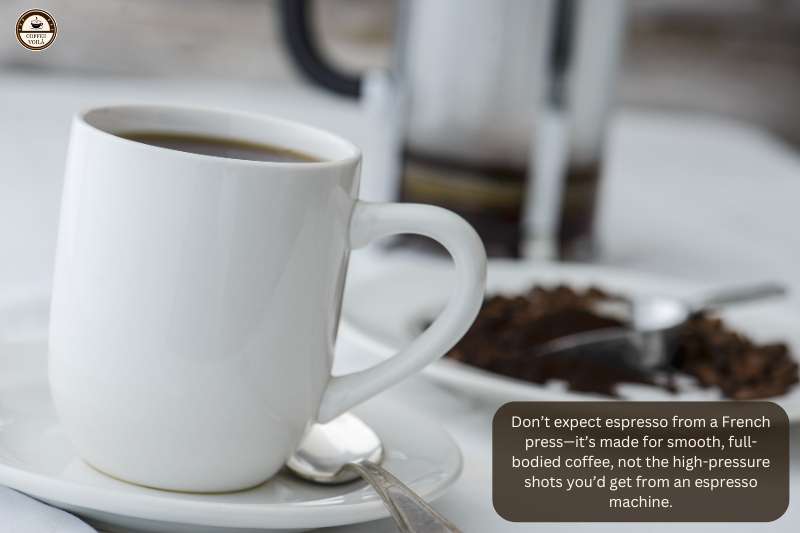
So what does this mean?
Simply put, a French press isn’t built for that kind of extraction. If you want true espresso, you’ll need a proper espresso machine or at least a moka pot.
A moka pot won’t give you espresso shots either. However, it comes closer with that stronger and concentrated taste.
The beauty of the French press lies elsewhere: smooth, rich coffee with natural oils and a heavier mouthfeel than drip coffee. It shines when you embrace it for what it is, not what it isn’t.
Tip: If you’re chasing lattes or cappuccinos, brew a stronger French press (use a 1:12 ratio instead of 1:15) and pair it with frothed milk. It’s not espresso, but it scratches the itch pretty well.
Pro Tips for Brewing the Perfect French Press
Once you’ve dodged the big mistakes, there are a few extra tricks that can make your coffee even better. Besides, these aren’t complicated steps, but they make a difference.
Use fresh, filtered water
Water is 98% of your coffee. So if it tastes weird out of the tap, your coffee will too. For this, a budget-friendly water filter pitcher can significantly improve your brew with minimal effort.
Preheat the French press
Pour a little hot water in first, swirl it around, and dump it out before adding your grounds. This keeps the glass warm and helps your coffee stay at the ideal extraction temp.
Experiment with ratios and timings
The “standard” ratio is 1:15, but if you like a bolder brew, try 1:12. Similarly, you might prefer 3 ½ minutes instead of 4. In other words, experiment until you find what works for you.
Try different beans (light vs dark roast) for variety
A dark roast will taste bold and rich, while a light roast brings out fruitier or floral notes. For this reason, switching up beans can make your coffee taste like a new brewer.
Tip: Keep a little notebook of your ratios, timing, and beans. It sounds nerdy. But it saves you from guessing and helps you repeat the cups you actually loved.
Last Thoughts
Now I’m curious: have you been making any of these mistakes without realizing it? And which tip will you try first in your next brew?
Drop your thoughts in the comments below. If this guide helped you, share it with a fellow coffee lover who deserves better mornings. And with that voilà!!

